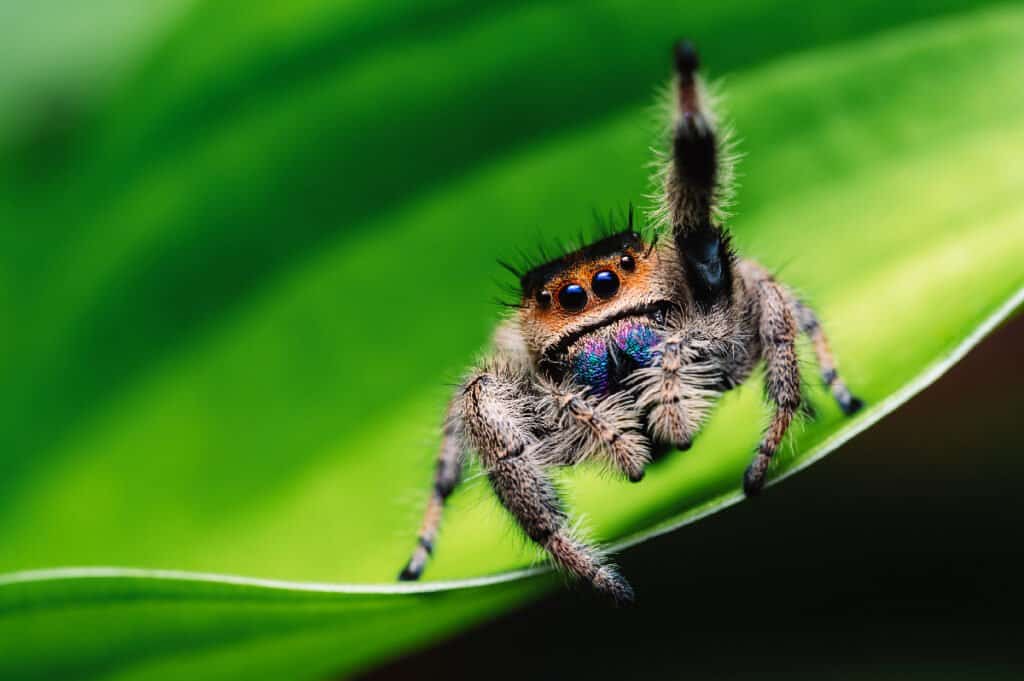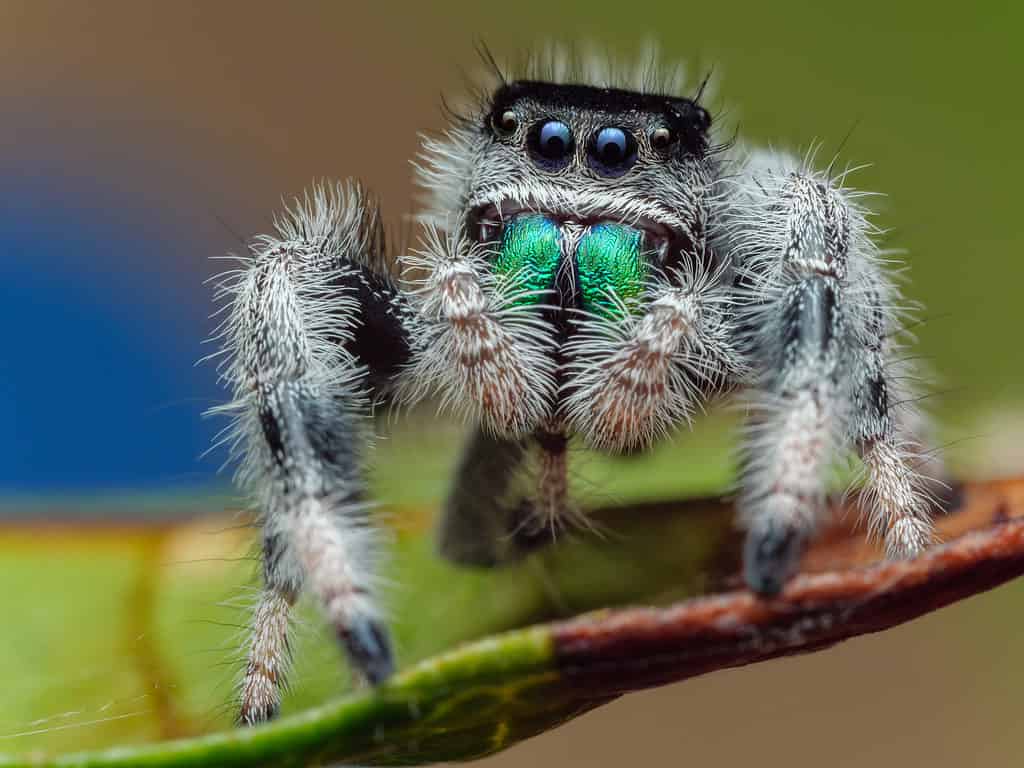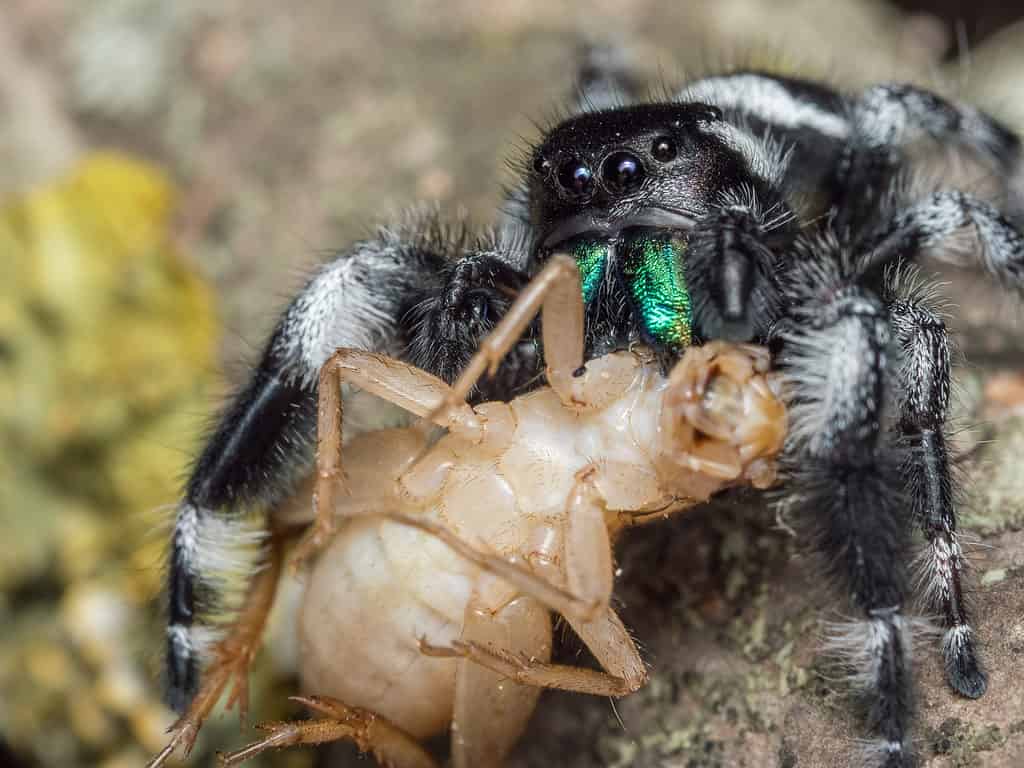Regal Jumping Spider
The regal jumping spider is the largest jumping spider in North America
Advertisement
Regal Jumping Spider Scientific Classification
Regal Jumping Spider Facts
- Prey
- Insects
- Main Prey
- Crickets, flies, and aphids
- Name Of Young
- Spiderlings
- Group Behavior
- Solitary
- Fun Fact
- The regal jumping spider is the largest jumping spider in North America
- Distinctive Feature
- Females have an orange pattern, while males have a black and white patterned body
- Other Name(s)
- Jumping spider
- Habitat
- Pantropical woodlands or open fields
- Diet
- Carnivore
- Lifestyle
- Diurnal
- Favorite Food
- Fruit flies
- Type
- Jumping spider
- Common Name
- Regal jumping spiders
- Special Features
- Rows of large black eyes
- Origin
- United States
- Number Of Species
- 1
Regal Jumping Spider Physical Characteristics
View all of the Regal Jumping Spider images!
The regal jumping spider, also known as the Phidippus regius, is a species of jumping spider that can be found in the southeastern United States. This is a type of jumping spider that is often kept as a pet in captivity. Regal jumping spiders are small and have an attractive coloration that makes them unusual exotic pets.
Often found around Florida, regal jumping spiders are known for being the largest species of Phidippus.
3 Facts About Regal Jumping Spiders
- Regal jumping spiders create elliptic webs that have two exits on either side.
- They are the largest species of Phidippus found in eastern North America.
- Regal jumping spiders are sexually dysmorphic, and it is easy to tell the male and female apart by their appearance.
Regal Jumping Spider Species, Types, and Scientific Name
The regal jumping spider belongs to the Salticadae family, which is one of the largest family of spiders, having around 6,000 different types. They are a type of jumping spider from the Phidippus genus and are scientifically known as the Phidippus regius.

The female regal jumping spider is larger than the male and has an orange and gray pattern on their bodies.
©iStock.com/Jan Rozehnal
Appearance: How To Identify Regal Jumping Spiders
Regal jumping spiders are sexually dysmorphic, which makes it easy to distinguish between a male and a female by looking at their characteristics. The female regal jumping spiders have the most color and grow to a larger adult size of 0.28 inches to 0.87 inches, while males reach a size of 0.24 inches to 0.71 inches.
The male regal jumping spider has an entirely black coloration, which is why they are mistaken as black widows. They also have white spots and stripes along their bodies in the same type of pattern as females. The male regal jumping spiders are smaller than females, but both regal jumping spiders have small bodies with sets of large black eyes that give them a cute appearance.
Female jumping spiders are well-known for their coloration, which consists of orange and gray patterns on their bodies. Regal jumping spiders have fine hairs that cover their entire bodies, and their jaws have a bluish-green iridescent color.
Both male and female regal jumping spiders have three dots on their abdomens that resembles a smiling face.

Regal jumping spiders (
Phidippus regius) have fine hairs that cover their entire bodies, with jaws of iridescent color.
©iStock.com/Macrolife.it
Habitat: Where To Find Regal Jumping Spiders
Regal jumping spiders can be found in tropical regions, usually in the southeastern United States and in the West Indies. Regal jumping spiders were first found in the West Indies and the United States, but they are mostly found in Florida.
You will find the regal jumping spider in the following places:
- Southeastern United States
- Florida
- West Indies
- Greater Antilles
- Texas
- Bahamas
- South Carolina
- Georgia
- Alabama
The regal jumping spider’s habitat consists of woodlands or fields in the herbaceous zone. The subadult regal jumping spider seems to prefer the semiarid habitats that consist of palmettoes and palms. Regal jumping spiders will construct their webs in trees, shrubs, or similar vegetation. When living close to humans, adult jumping spiders will create a home in wall cracks.
As a pantropical species of jumping spider that prefers a warmer climate, the ideal temperature for a regal jumping spider would be between 80 to 86 degrees Fahrenheit like in their native range of southeast North America. If you keep a regal jumping spider as a pet, you will need to replicate their warm temperatures and ideal climate by keeping the enclosure between 75- and 82 degrees Fahrenheit.
The ideal humidity requirements for this species range from 50% to 60%, which can be achieved through light misting during the day if you keep a regal jumping spider as a pet.
When keeping a regal jumping spider as a pet, their enclosure should closely resemble their natural habitat. An adult regal jumping spider can be kept in an enclosure measuring 6×6×10 inches in size, providing them with enough space to display their normal habits.
If the enclosure is too big, they might have a difficult time finding food.
The enclosure should have more vertical than horizontal room, and the air holes in the enclosure should provide adequate ventilation throughout the enclosure without being big to the point that your regal jumping spider can escape. Warm and humid are good conditions for the regal jumping spider, with plenty of branches and plants for them to create a good webbing.
Diet: What Do Regal Jumping Spiders Eat?
Regal jumping spiders are carnivores and hunters during the night when they will leave their webbing to hunt for food. Insects are the regal jumping spiders’ main prey, such as small crickets or mealworms as a staple food source.
They will only eat between three to four times a week. In the wild, regal jumping spiders will leave their silken nests to look for food, which is found to be common pests on citrus plants and sugarcane, along with flies (Diptera), aphids, and cicadas (Hemiptera), shield bugs, crickets, and locusts (Orthoptera).
Regal jumping spiders are quick to move and will prey upon small insects that they find moving around in their enclosure. Instead of waiting for insects to land on their webbing, regal jumping spiders prefer to hunt their prey, similar to the feeding habits seen in tarantulas.

Regal jumping spiders rely mostly on insects such as crickets as their primary food source.
©iStock.com/Macrolife.it
Regal Jumping Spider Reproduction and Lifespan
Male regal jumping spiders will mate with several subadults to adult female regal jumping spiders before dying. The female regal jumping spiders create a nest made of their silk to lay eggs, generally in tree bark. The first batch of eggs is around 180 to 200 eggs, and the number of eggs declines as the regal jumping spider ages. Female regal jumping spiders will only lay around four batches of eggs during their lifetime.
The lifespan of a regal jumping spider is fairly short, and they typically live no longer than 10 months in the wild. However, in captivity, the regal jumping spider can live between 1 to 2 years of age. They mature and reach adulthood by shedding their exoskeleton (a process known as molting), which is a spider’s way of growing.
Related Animals
View all 114 animals that start with RRegal Jumping Spider FAQs (Frequently Asked Questions)
Are regal jumping spiders dangerous?
The regal jumping spider is not dangerous or harmful to humans. The small amount of venom that they inject into their prey is not enough to do any harm, even if they do bite you. The bite can feel like a slight pinch, and you may experience some mild pain. Regal jumping spiders will only bite if they feel like they are in danger, usually if you squeeze them during handling.
How many legs do regal jumping spiders have?
Like other arachnids, the regal jumping spider has a total of 8 legs.
What do regal jumping spiders eat?
Regal jumping spiders are carnivores (or informally described as insectivores). They hunt prey at night such as locusts, crickets, mealworms, flies, aphids, and cicadas. In captivity, regal jumping spiders enjoy eating fruit flies and mealworms, or any prey that is not bigger than their body.
How long do regal jumping spiders live for?
Regal jumping spiders do not live for very long, and their average lifespan ranges from 10 months to 1 year, typically living longer in captivity.
Can a regal spider be kept as a pet?
Regal jumping spiders are kept as an exotic pet, and their docile nature and tendency to cohabit peacefully with humans makes them an excellent yet short-lived pet for arachnid lovers.
Since regal jumping spiders are active during the day, you will get to watch your regal jumping spider jump and roam their enclosure to build a silky nest.
Thank you for reading! Have some feedback for us? Contact the AZ Animals editorial team.
Sources
- University Of Florida Entomology & Nematology, Available here: https://entnemdept.ufl.edu/creatures/misc/regal_jumping_spider.htm
- Everything Reptiles, Available here: https://www.everythingreptiles.com/regal-jumping-spider/
- Wikipedia, Available here: https://en.wikipedia.org/wiki/Phidippus_regius

















